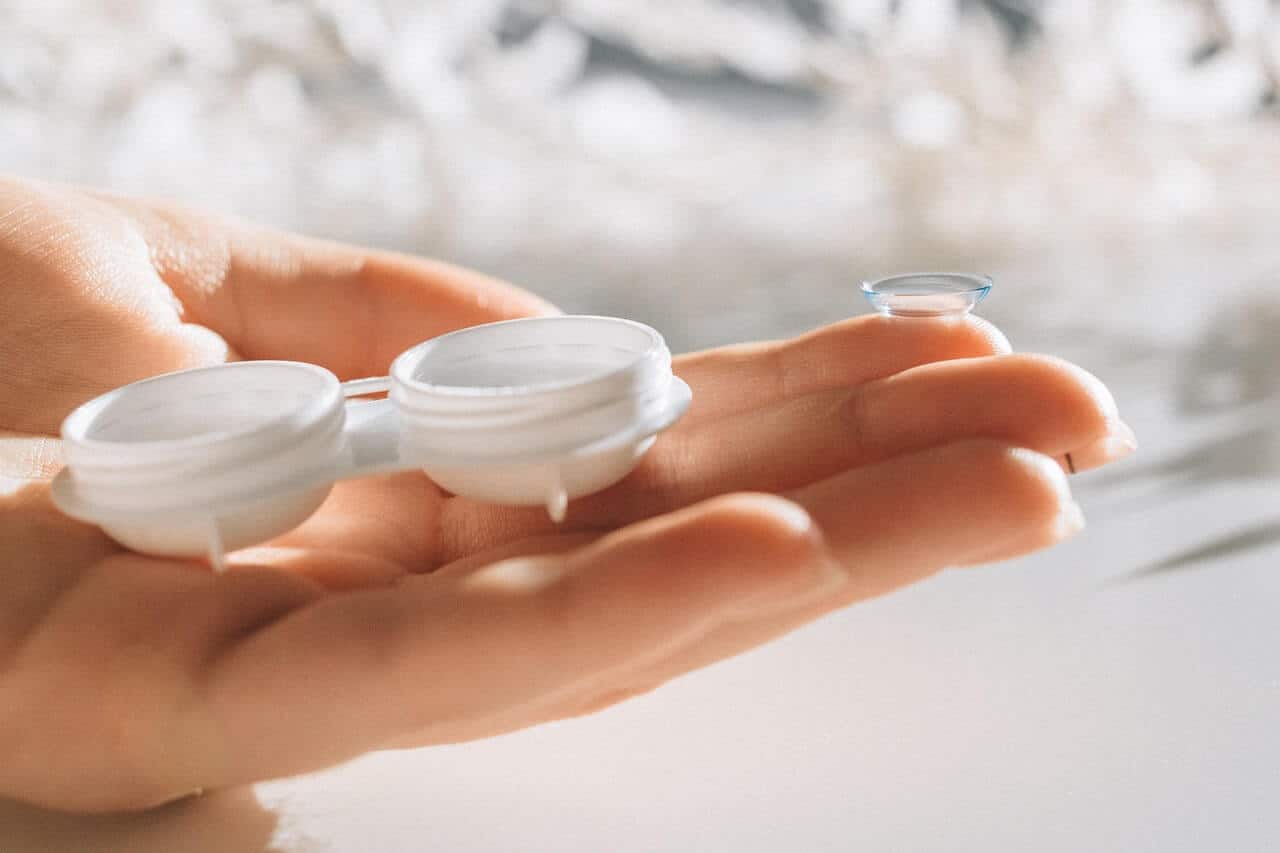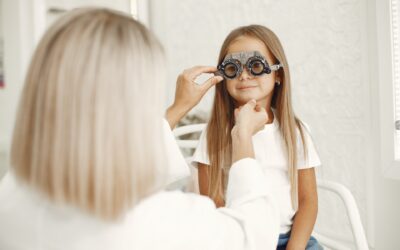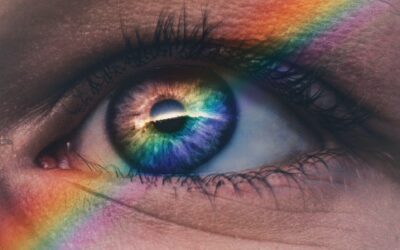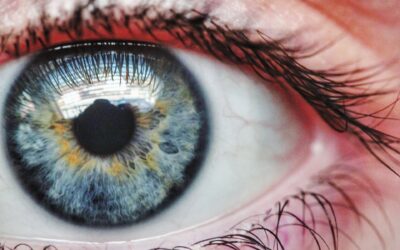Contact lenses eliminate the need for having to wear glasses, which can be beneficial for sports, cosmetic reasons, and the ability to see outside the limitation of a glasses lens.
In today’s world, with so many different outlets for getting contact lenses, it is more important than ever to understand why you should see your eye doctor yearly and how to properly care for your lenses.
What Does an Optometrist Consider When Prescribing Contacts?
When prescribing corrective lenses—whether they be glasses or contacts—your eye doctor takes many different parameters into consideration including: the distance between the correction and your eye (known as the vertex distance), what your primary working distance is (are you wanting to see best up close, far away, or at an intermediate distance?), the shape of your eye, the health of your eye, and many others.
Contact lenses are a little more complicated than glasses because they fit directly onto the eye and therefore need to sit just right to allow for optimal vision. Your eye doctor will take many different measurements before choosing the best lens for you—sometimes this takes multiple attempts!
Contact lens fittings can be broken down into two major categories—finding a lens that is comfortable and finding a lens that optimally corrects your vision.
At the beginning of a contact lens evaluation, the eye doctor must evaluate the health of your cornea—the very front clear structure of the eye. Your eyes need to be free of any surface disease or infection prior to wearing a contact lens.
Next, your eye doctor will take some measurements to determine what size lens would be best for your eyes, as well as mapping out the curvature of your cornea to make sure the lens is not too flat (resulting in a loose fit) or too steep (resulting in a tight fit) for your eye.
Arguably, the most important part of fitting a contact lens is ensuring that it properly corrects your vision. Since the lens sits directly on your eye, your glasses prescription will need to be converted to a contact lens prescription.
Yes, you read that right. Believe it or not, your glasses prescription and your contact lens prescription are not the same thing!
Glasses prescriptions and contact lens prescriptions can be converted interchangeably using several different complex equations. However, just because a person’s glasses prescription mathematically computes to a certain contact lens prescription does not necessarily mean that ordering the converted prescription will result in optimal vision.
Once your doctor has made all of these measurements and selected what is believed to be the “perfect” lens for your eye, they need to take a look at the lens on your eye to determine if this is actually the case.
The human eye is like a finger print—no two are the same. Therefore, your doctor will need to take your input into consideration when fitting your lens to make sure your vision is the best it can be. He or she may need to tweak a parameter or two to get your prescription exactly right.
Sometimes everything fits great and you may see great, but the lens is not comfortable. Your doctor may need to switch brands or materials to find a lens that is more comfortable to you.
Or, sometimes a lens fits great and is comfortable, but the contact lens needed for your exact prescription does not exist. Therefore, your doctor may have you try two different sets to determine which lens you see the best out of, and you may have to settle a little on not having “perfect” vision.
But wait, glasses can be made to your exact prescription, so why can’t contact lenses?
As noted above, contacts sit directly on your eye. The eye is a wet, round surface, so lenses tend to move around when blinking, looking to the right or left, up or down, etc. The main point to note here is that contact lenses have some movement whereas glasses lenses do not. This complicates things a little bit.
Contact lenses are also made in bulk by contact lens manufacturers. Since there is an infinite number of different prescriptions possible, contact lens companies have to put some limit to what they make, otherwise some lenses would be bought all the time, and others would sit on shelves for years and eventually go bad and need to get thrown away.
Therefore, unlike glasses that can be made exactly to a very specific prescription, contact lenses have to be estimated and altered to fit what is available. Your eye doctor has to make this decision each and every time your glasses prescription is adjusted.
Here’s an example patient to help explain this system:
Let’s say a person has a glasses prescription of -6.25 -3.25 X 163. After converting this prescription from glasses form to contact lens form, the “optimal” contact lens prescription would be: -5.81 -3.11 X 163.
Prescriptions are written to the nearest quarter diopter (.00, .25, .50, or .75). For a patient with astigmatism, the available axes in contact lenses are to the nearest 10th, (i.e. X 010, X 100, X 180, X 160, X 170, etc.) Thus, this is where the doctor would need to do some educated trial and error work to find the lens that would best for this example patient.
A good place for the doctor to start would be a lens that is -5.75 -3.00 X 160. However, the doctor could also try a -6.00 -3.00 X 170, or a -5.75 -3.25 X160, or a -6.00 -3.25 X 170, or other combinations of these options.
Then, perhaps after all this calculated decision making, the doctor puts the lens on the patient’s eye and the lens rotates. Now even more calculations have to be considered to make sure the patient’s vision is corrected in the proper manner!
As you can see, it is not quite as straightforward as one might think!
Different Contact Lens Options
There are hundreds of different contact lens options in existence. In fact, every few months an entire book is published to give eye doctors the complete list of contact lenses and their available parameters.
Contact lenses are available as spherical only lenses (i.e. no astigmatism correction), or can correct for astigmatism as well. Astigmatic contact lenses are referred to as “toric” lenses.
Contact lenses that correct for astigmatism tend to be a bit more expensive, so if you have a low amount of astigmatism your eye doctor may try to adjust your prescription to be a spherical contact lens in order to help you save money. This does not work for all patients—only sometimes in those with very small amount of astigmatism (-0.25 to -0.50 diopters)
Contact lenses can also be used to change your eye color! In today’s market, essentially any color is available. Some of the most common colors are blue, green, purple, grey, or hazel.
Another of the most notable differences between contact lenses is their wear schedule. Some lenses are meant to be worn for 1 day only, others may be worn for up to a month, 3 months, etc.
It is very important that you know what your lens wear schedule is and that you discard and change out your lenses as recommended. Over-wearing your lenses can lead to infections and even permanent damage to your eyes.
Daily contact lenses tend to be a little more expensive, but are a great option for children, individuals who have allergies, those with dry eyes, or those who only like to wear lenses every now and again for special occasions.
Monthly lenses must be taken out every night and stored in a contact lens case. They tend to be a little more affordable than daily disposable lenses. It is recommended that these contacts be replaced on the same day every month (for example, the 1st of every month) to help to remember when to change lenses as to not over-wear an old lens.
There are also lenses that can be approved to sleep in, but there are not quite as many prescriptions options for these lenses as other types, as it is not recommended to sleep in contact lenses.
The Do’s and Don’t of Contact Lenses
Do NOT swim or take showers in your contact lenses. Bacteria and fungi within the water system are known to latch onto contact lenses. When these sit on your eyes all day long every day it can lead to some very serious infections.
Do replace your contact lens case every month. Bacteria like dark, warm, moist environments—like contact lens cases! You might be cleaning your lenses properly, but putting clean contacts into an old, contaminated contact lens case will only transfer the bacteria to your lenses, which will be put into your eyes, and will result in a nasty infection.
Do replace your contact lens solution each night. Letting solution sit in a case all day is asking for bacteria to move in and proliferate in the solution. Just as mentioned above, this can result in bad infections!
Do NOT sleep in your contact lenses. When we sleep, our eyes get less oxygen and dry out a little bit. When this happens, the contact lens shrinks up slightly and will tighten onto your eye—allowing even less oxygen to get to your eye. This is very dangerous!
Do replace your lenses as directed. If your lens is a monthly lens, it must be replaced after 1 month—even if you only wore it a couple of times! Lenses only stay “good” for a given amount of time. If you have a 2-week lens, it will go “bad” 2 weeks after it was removed from its foil package. Not properly disposing lenses after the time indicated by the manufacturer increaes your risk for infection.
Do discard contact lenses after they have expired. All boxes of contact lenses should be marked with an expiration date (if not, you shouldn’t be wearing that brand!). Just like medications, contact lenses expire. New contact lenses are stored in air-tight foil packets filled with a sterile solution. After the expiration date, the sterile solution has lost its effect and the lenses could be contaminated with bacteria. It is also possible that the expired lenses have lost their integrity and may no longer properly correct your prescription. Either way, it is not safe to wear expired lenses (or use expired solutions!).
Do NOT overwear your lenses. This is super important. Overwearing your lenses increases risk for infection, results in poorer optical quality, and can damage the structural integrity of the eye. One of the most common findings in contact lens over-wearers are corneal ulcers. These are very painful and can result in permanent vision loss, sometimes even blindness, if they occur on the central cornea.
Do clean your contact lenses every night. There are different types of solutions, but be sure yours has a disinfectant property to it and manually rub your lenses to ensure bacteria, debris, makeup, dirt, etc. are removed from the lenses prior to inserting them into the case for storage each night.
Do NOT fib to your eye doctor when they ask you questions about your contact lens care. Contact lenses are a wonderful tool for those who have prescriptions but do not want to be hindered by the glasses lifestyle. They are safe when used as directed. It is of utmost importance that you tell your eye doctor the truth about how you handle your contact lenses—they will not judge you, they only want what is best for your eye health. If you are not honest with your doctor, they may not be able to help you properly when problems arise. Who knows, there might be a better options to suit your lifestyle and preferred care regimen! Open conversations with your doctor are key.





